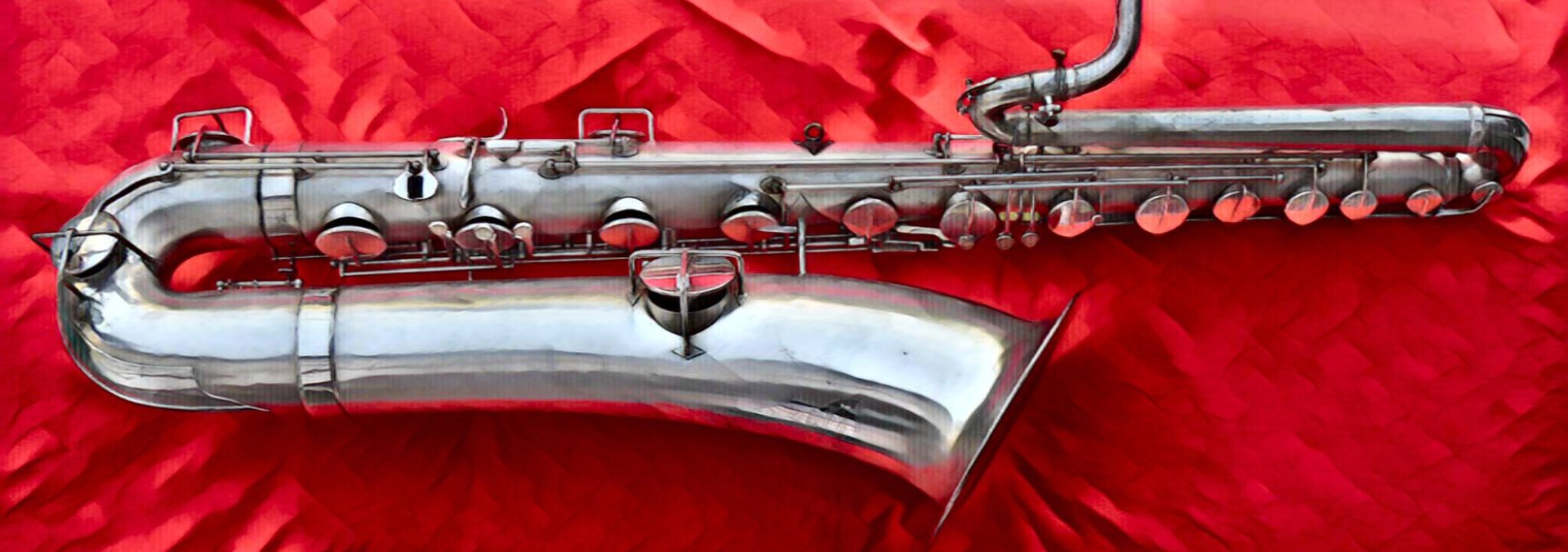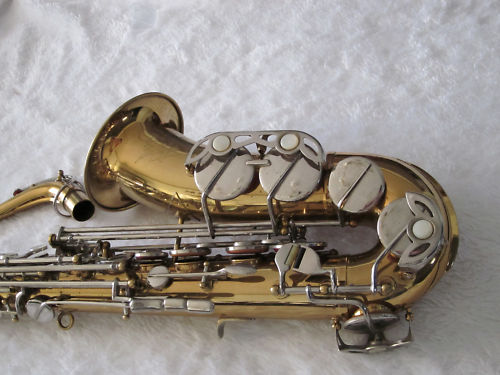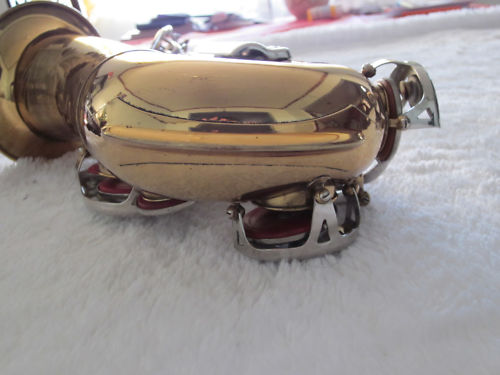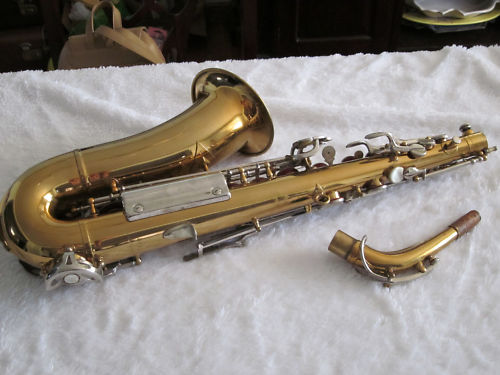Yes, you read that right. The German saxophone manufacturer—renowned for making copies of J. Keilwerth saxophones—stencilled saxophones for SML. As a matter of fact, there is a D&J-stencilled SML alto on eBay at the moment.
Source: eBay.com
Now before you go thinking that perhaps someone buffed off the original name, and re-engraved the SML name on this D&J horn, here’s another SML alto made by D&J that appeared on Detroit’s Craig’s List last year.
The seller of the sax currently on eBay describes the horn like this:
Up for sale is a MARIGAUX SML Paris Alto saxophone. The sax is in NEAR MINT condition. About 99% or more of beautiful original lacquer is still present. It does have rolled tone holes. Body and neck have the same series number of 85xx. This sax was made probably in the 40s-50s or 60s. Pads look old, so buyer should make a call on either adjusting or replacing them. All keys move smoothly & freely .There is NO dent, but there are minor scratches & tiny dings as you expect from an old horn. I acquired this sax from a retired pro who used this sax as a backup horn for his SBA. Yet, since then it’s been sitting in my collection. Also, this sax is a puzzle for me since it was made in GERMANY. If you’re a German sax collector, you might know more about it. As for me, I hardly can find any info about this rare sax, and it doesn’t look like my Gold Medal SML . This sax is very well built and definitely NOT a cheap one. It should be a nice vintage horn for someone who is willing to bring it back as a performer again. Sax was made to perform, so I’m rather Not keeping it in my collection any longer. So, This sax definitely needs a new owner who can give it love.
This sax comes with a non original case and a mouthpiece.
1/23/11
Thanks for info from few knowlegeable ebayers who pointed out that this sax has Keilwerth as its parent company. I compared it to my Superba I and found that the shape of posts, tonehole positions & keywork appear very similar. So, It might indeed a Keilwerth or D&J sax.
In case you have any doubts about this SML’s pedigree, I’ll give you some examples of other Dörfler & Jörka-made horns so that you can compare them.
Check out this René Dumont 14462. Among the other similarities, on the SML you can make out D&J’s round thumb screw that fastens the neck.
Source: eBay.com
Here you can see that the SML is identical to this Voss 163XX.
Source: eBay.com
This is the bow guard of René Dumont 14231. Note the shape of the decorative holes in the key guards. They are the same as in the SML.
Source: eBay.com
Here is the left side of an Artist #300, serial # 11174. Do you see a difference? I don’t see a difference. 😉
Note the shape of the octave lever and left thumb rest on this Roxy 11036. This is classic D&J.
Source: eBay.com
And you’ll see the left pinkie cluster is the same on the SML as it is on this Senator 11255.
Source: eBay.com
This Dörfler & Jörka-made SML alto indeed appears to be in very nice condition.
If you’d like to read more about Dörfler & Jörka saxophones, check out the D&J page on the main portion of my site. There you’ll find the company’s history, and lots of pictures that compare and contrast the horns to J. Keilwerth saxophones of similar vintage.
The auction for this D&J-stencilled SML alto runs until February 20. The Buy It Now price of the sax is $600.









JunkDude.com’s got another SML D&J:
I’ve seen this horn on Dave’s site for quite some time Pete. I have a funny feeling it is the same one that the fellow was trying to sell while ago. Remember when all that speculation arose on SOTW, and people thought it was a “fake”, and that someone had just used this D&J to added the SML engraving. (This was the same time that someone brought it to our attention on the WF.) The horn’s auction was abrubtly ended on eBay IIRC, and within a few short weeks suddenly this SML ended up on Junkdude’s site. Coincidence? Maybe, but I’m not a big believer in them.
Compare Dave’s pics to the ones from original eBay ad, and you’ll see what I mean.
Update: Well this rather controversial horn did not sell. By the time the auction ended on Feb. 20 there had been well over 1500 views of the auction, but not no one bought the horn.
SOTW’s lively conversation about it being a fake didn’t help the auction any I don’t think.
Bottom line: I don’t believe this horn to be a fake. It is simply a D&J stencil. As Pete Hales said: SML was known to have contracted other companies to make horns for them.
Nothing wrong with a stencil horn. I’ve been trying to get some info about what really was going on behind the iron curtain. But hard to get correct info. Musica (trademark) had thier office and ”plant” in the town Steyer in Austria. Sometimes you can see saxes stamped Musica Steyer but the were manufactoried by Denak CZ, (the manufactor of Amati saxes). According to the mayor office in Steyer there was not a real manufactoring going on in the plant. They just made instruments ”ready for the market” . In what way they couldn’t say. UMI also had thier office in Steyer. UMI was a part of the conglomerate Skåne Gripen, a Swedish company, for some years in the 80’s.
Back to the SML alto. Most D&J saxes had tubes from Keilwerth. Also the SML stencilsaxes?
My former tech worked at SML in France for some years in the late 60’s and early 70’s. He was on the guarantee repair dept but he also worked on the ”line” building tenors and altos. He knows a lot about SML saxes. When we met to blow Rocksax he is really looking deep into the SML saxplayers that shows up. The other year it was BINGO for him. A player had bought a SML tenor that he built!!
IMO. The saxophone manufactoring world is mixed up!!
I didn’t realize that UMI had a Swedish connection. Very interesting.
As far as D&J and the Keilwerth saxes goes. Only the very early D&J saxes had Keilwerth body tubes. That was when they were under contract to provide the key work to the supplied body tubes. This only lasted a little over a year (from March 1949 to September 1950). For the next 18 years—until D&J completely shut its doors in 1968—the company produced both the body tubes and the key work. The saxes that D&J built were near copies of the J. Keilwerth Toneking and The New King models. This copying is what brought some legal troubles for D&J when Keilwerth took them court (a court case that Keilwerth lost).
Depending on when your tech started to work for SML, he might know what the company did with regards to ordering stencils from other companies.
I agree with you, the saxophone manufacturing was, and is still, very messed up. I think in the future people are going to have just as a hard a time trying to figure out who built what now, as we are trying to unravel the mysteries of the past. The difference is, that so many of today’s horns are such junk, that they will no longer be around, or that no one will care. 😈
Hi Pete. Thanks for chiming in with your thoughts on this rather strange, and apparently controversial horn.
You say:
To that I would add another really famous example.
In the early 80s, J. Keilwerth was awarded a large contract for baritone saxophones. The company did not have the capacity to fulfill the contract on time, so J. Keilwerth awarded a subcontract to B&S to build 300 low A baritones. This cooperation lead to much know how being transferred from J. Keilwerth to B&S, which later improved the baritones that B&S built.
In this case, an established saxophone manufacturer, chose to partner with another established manufacturer, in order to meet contractual deadlines.
I offer this up as yet another example of how some stencil horns can come into existence.
Howdy. As many of y’all know, I’m the guy that created saxpics.com and did a lot of the current research on SML.
First, just wanted to mention that Helen’s right: I’ve absolutely no problems saying that this is a D&J horn. Not only can this “SML” be compared with other known D&J produced horns, there are other “SML”-labeled D&J horns that we have pics of.
Second, there were a couple of companies that did produce saxophones for SML before they decided to make their own saxophones. After SML started chugging along, at least two other companies produced the occasional stencil for SML, most notably Beaugnier.
There’s precedence for a well-known sax manufacturer making horns for another well-known sax manufacturer. Probably the best proof of this was when I found a Buffet Dynaction all stamped and engraved … for Selmer.
One of these days I’ll revisit the topic of folks that stenciled horns for SML. It’ll be awhile, tho :).